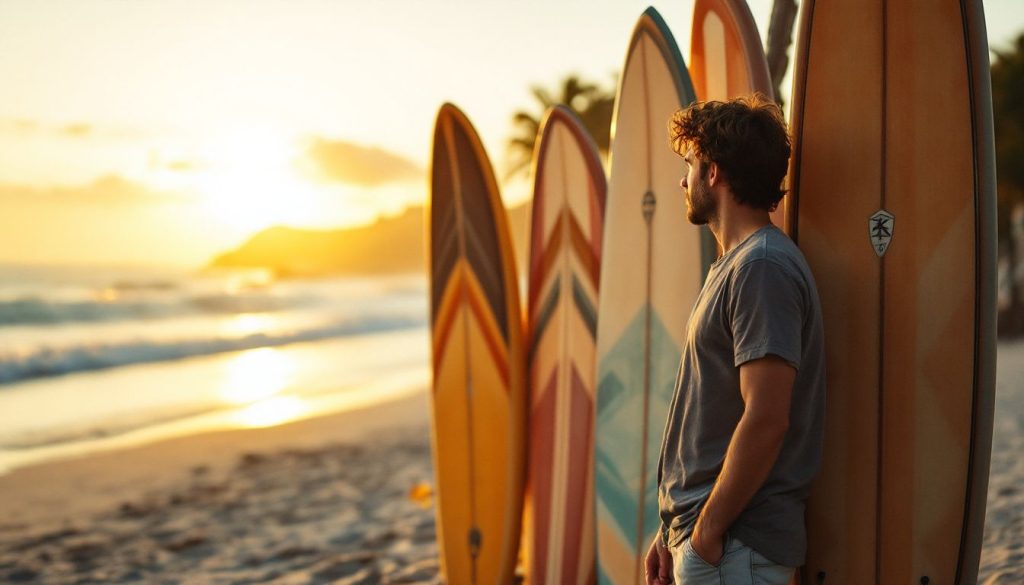Choosing the right surfboard can be tough. Did you know traditional surfboards have a rich history? This post will show you their unique styles and benefits. Keep reading to learn more.
Types of Traditional Surfboard
Traditional surfboards come in various types, such as Alaia surfboards, Log surfboards, Wooden Longboards, and Retro Fish Surfboards. Each type offers unique characteristics that contribute to the surfing experience.
These traditional surfboard types are crafted using ancient techniques and materials like Wili Wili, Ula, and Koa wood which have been used for centuries in Hawaiian surf culture.
Alaia Surfboards
Alaia surfboards come from Hawaii. Long ago, Hawaiians made these boards to ride waves. They are thin, long, and have no fins. People use special wood like koa to make them. These boards need skill to use because they move fast and smooth in the water.
Surfing on an Alaia takes us back to the roots of surfing culture. This shows how people still enjoy old styles of surfing today. Riding an Alaia connects surfers with history and tradition.
Log Surfboards
Log surfboards are a classic type of longboard. They date back to the 1950s and 1960s. These boards are known for their size, usually over nine feet long. Surfers love them for noseriding and smooth maneuvers on waves.
Log surfboards stand out because they are thick and wide.
They have a single fin setup at the back. This design helps with stability in water. People use log surfboards for traditional style surfing. They offer a slow, graceful ride on the wave.
Surfing with a log board feels like stepping back in time, enjoying the simple pleasure of wave riding.
Wooden Longboards
Wooden longboards are classic surfboards that stand out for their traditional design and use of natural materials. Crafted from types of wood like Wili Wili, Ula, and Koa, these boards carry a piece of surfing history.
They are known for features such as noseriding and smooth maneuvers on the waves. Builders shape them using ancient techniques passed down through generations. This makes each board not just a tool for riding waves but also a work of art.
Riders favor wooden longboards for their durability and the unique feel they offer in the water. Unlike modern foam and fiberglass boards, wooden ones require more skill to master due to their weight and size.
Yet, many find this challenge rewarding, linking them closer to surfing’s roots. Moving forward introduces another vintage style—the Retro Fish Surfboards.
Retro Fish Surfboards
Retro fish surfboards are a classic type of traditional surfboard, known for their wide and short shape. These boards originated in the 1960s as part of the evolution of modern surfing.
Their design features parallel rails and a wider tail, which promote speed and maneuverability on smaller waves compared to other traditional longboards. The retro fish design has made a comeback due to its fun and easy ride, making it popular among surfers looking for an alternative to high-performance shortboards.
Moving on from retro fish surfboards, let’s explore the materials used in traditional surfboards.
Materials Used in Traditional Surfboards
Traditional surfboards are crafted from Wili Wili, Ula, and Koa wood, using ancient techniques that reflect the rich heritage of wave riding. To learn more about the craftsmanship and cultural significance behind these materials, continue reading.
Wili Wili, Ula, and Koa Wood
Wili Wili, Ula, and Koa wood are commonly chosen for crafting traditional surfboards. These woods have been historically favored by Hawaiian artisans due to their lightweight yet durable nature.
Koa wood, specifically, is highly sought after for its beautiful grain patterns and rich coloring. Its growth is regulated in Hawaii due to its cultural significance. The use of these indigenous woods does not just reflect the deep connection to Hawaiian heritage but also contributes to the sustainability of traditional surfboard making.
Crafting surfboards from Wili Wili, Ula, and Koa wood demands skill and precision to maintain strength without adding excessive weight. This attention to detail extends beyond functionality; it honors the ancient artistry deeply rooted in Hawaiian culture.
The inclusion of these woods guarantees that each traditional surfboard not only showcases exceptional craftsmanship but also embodies a profound respect for both tradition and natural resources.
Traditional Techniques of Crafting
Crafting traditional surfboards is a meticulous process that demands skill and precision. The techniques are passed down through generations, ensuring the authenticity of each board.
Artisans carefully handcraft these boards using ancient methods, often relying on simple tools such as chisels and planes. They thoughtfully select the wood, shaping it with dedication to create a functional yet beautiful surfboard.
The process of crafting traditional surfboards involves great attention to detail in order to maintain the integrity of the design. Each step, from selecting the wood to applying finishes, is done with care and respect for tradition.
These techniques result in timeless surfboards that embody both functionality and artistic expression.
Key Features of Traditional Surfboards
Traditional surfboards are known for their unique design and shape, often featuring smooth maneuvers that enable noseriding. To learn more about these classic surfboard features, continue reading the blog.
Design and Shape
Traditional surfboards often feature a long and narrow shape, which enables smooth maneuvering on the waves. Their design typically prioritizes a rounded nose for stability and a wider tail to provide enhanced control while riding.
These surfboards are commonly constructed from Wili Wili, Ula, and Koa wood, utilizing age-old methods. They exemplify classic surfboard shaping with a focus on graceful curves and craftsmanship intended to enrich the rider’s experience in the water.
Now, let’s move on to “The Presence of Fins in Certain Models” to investigate how some traditional surfboards differ from modern designs with regard to fin configuration and its influence on surfing behavior.
Absence of Fins in Certain Models
Moving from the design and shape, some traditional surfboards stand out due to their absence of fins. The Alaia surfboard, for instance, a model originating from Hawaii in ancient times, lacks fins.
It is made from wood and designed for finless wave riding to allow smooth maneuvers on the water. Similarly, Retro Fish surfboards typically feature twin keels instead of a single fin or three fins seen in modern shortboards.
These keels provide stability and control without the need for traditional fins.
These models showcase how surfing has evolved through time with varying designs and features that cater to diverse riding styles such as noseriding or smooth maneuvers without relying on conventional fin setups commonly found in modern surfboards.
The Cultural Significance of Traditional Surfboards
Traditional surfboards hold significant cultural importance, especially in Hawaiian and Polynesian cultures. These wooden boards are not only used for riding waves but also represent a deep connection to the ocean, nature, and ancestral heritage.
They have historically played a crucial role in ancient surfing practices, showcasing the close bond between indigenous communities and the sea.
The craft of making these surfboards has been passed down through generations, with craftsmen employing traditional techniques and materials such as Wili Wili, Ula, and Koa wood. Each board features distinct designs that narrate tales of culture and tradition.
Moreover, their utilization in wave riding mirrors a balance with nature and a reverence for the timeless art of surfing. These boards stand for more than just tools for beach activities; they encapsulate age-old traditions intricately intertwined with surf culture.
Modern Adaptations of Traditional Surfboards
Modern adaptations of traditional surfboards have brought new technologies and materials into play, enhancing performance while staying true to the classic designs. The resurgence of interest in wooden longboards has led to the integration of lightweight foam cores and fiberglass, blending tradition with contemporary advancements.
Importantly, these modern adaptations aim to maintain the timeless aesthetics and smooth maneuvers while improving durability and agility for surfers.
Integrating advanced materials like carbon fiber alongside traditional wood has resulted in durable yet flexible boards that offer a blend of nostalgia and cutting-edge performance.
This evolution allows surfers to experience the joy of noseriding on vintage-style boards with enhanced responsiveness. Furthermore, designers are blending computer-aided shaping techniques with ancient board building methods, delivering custom creations aimed at maximizing wave riding experiences.
These modern adaptations bridge historical craftsmanship with innovative engineering, bringing an exciting dynamic to the world of traditional surfing equipment.
Moving forward from this evolution, let’s dive into how these modern adaptations influence surfing culture and beach lifestyle.
Conclusion
Traditional surfboards hold a rich history and play an integral role in the evolution of surfing. From Alaia boards to retro fish surfboards, each type reflects timeless craftsmanship and cultural significance.
The enduring appeal of traditional surfboard design continues to inspire modern adaptations, keeping the spirit of wave riding alive. Whether it’s the smooth maneuvers on longboards or nostalgic styles, traditional surfboards remain a cherished part of beach lifestyle and surf culture alike.



